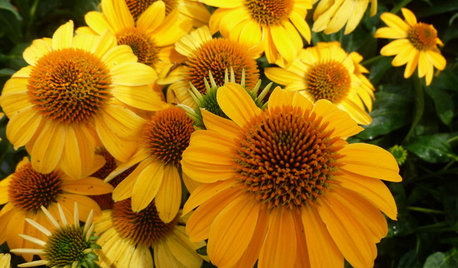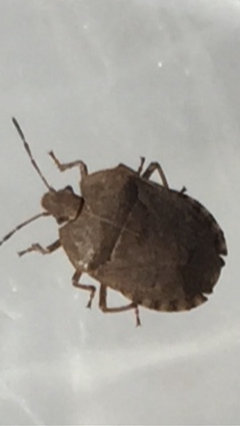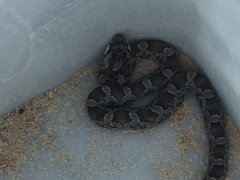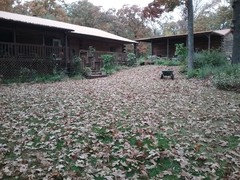October 2018, Week 5
Okiedawn OK Zone 7
5 years ago
last modified: 5 years ago
Featured Answer
Sort by:Oldest
Comments (28)
Nancy RW (zone 7)
5 years agoNancy RW (zone 7)
5 years agoRelated Discussions
October 2017 Week 5: Boo, Halloween Rain, Time To Turn Back the Clocks
Comments (63)Nancy, Gold is better than plain brown. Honestly, anything is better than plain brown. Around Thursday or so I noticed green leaves falling from some trees---they didn't even turn brown first. I think our trees are confused. Why wouldn't they be? Every week they are exposed to lows in the 30s and highs in the 90s. How they even know what season we are in at this point is beyond me. Currently it is 90 degrees at our Mesonet station and 89 at our house. There's reports of haziness and smoke in the air, but none of us are spotting any plumes of smoke, so I think that, as the rumored cold front moves across the state, it may be pushing smoke, fog, haze, smog, dust or whatever ahead of it. There was a 1,700 acre wildfire in the county west of us yesterday and it looked like smoke was hanging over the river this morning, so maybe it is that. Our gold foliage peaked around Thursday or Friday and is going to a dull golden brown today. I believe the hard freeze we had a few days ago has really impacted the tree foliage. Further south in Texas where the freeze didn't happen or at least was not as prolonged as it was here, they have better foliage color than we do right now. At least 3 or 4 of the red oaks in the yeard near our house have some red, and our big red oak near the road, which is my favorite tree, is beginning to show some red. It probably will peak next week though it is hard to tell in this weather. We turned back the clocks at bedtime last night so at least we'd be in sync with the rest of the area when we woke up today. It didn't matter what time the clock was showing---I woke up at the same time I do every single day, even if the clock showed it was an hour earlier. My body clock gets pretty firmly set on a time and doesn't really care what the clock says. It takes me at least a month to adjust to a time change and then before you know it, we're springing forward or falling back all over again. Jennifer, I'm glad you feel a little better today and hope you didn't cough your way through making the announcement at church. Hot and windy, hot and windy, hot and windy. It feels more like earliest September than early November. Chris sent me a text about a half-hour ago---a shooting at a church in Sutherland Springs, near San Antonio, TX. Word is several people were shot, including children, before police arrived and took out the shooter. He said he had heard 15 people were down, but I haven't seen any firm number on any media yet, and often early report are erroneous. It just seems to me like the world has gone mad---it is sad when people are not safe in church. And, in a state like Texas with open carry, it is unfortunate someone in that church wasn't armed because perhaps they could have stopped the shooter. It seems wrong to carry a gun to church, but we cannot kid ourselves---these shootings can happen anywhere any more. I'd like to be working in the garden, but all the swarms are still out there---Asian lady bugs, wasps, bees, yellow jackets....so I'm indoors. Oh, and the fire ants and harvester ants all are out and scurrying around. I guess maybe they are busy storing up provisions for winter. Dawn...See MoreWeek 5, January 2018: One Month Ends, Another Begins...and a blue moon
Comments (93)Patti, yes, I guess a leaky heart should be looked into. And loved your approach to the doctor! Way to go! You must be SO proud of your SIL and that whole family! That's doggoned impressive! And thrilled for your son and getting his bride-to-be back here, a little nervous about her getting in without any glitches. Exciting times for you! Does she speak Mandarin?? What part of China is she from? I just did cart seeds inside for the first time last year. It was surprisingly easy with the good help of all our smart friends here. They were even more help advising where and when and what to plant and filling the raised beds. Last year, I had no idea how to tell what I wanted in a tomato or pepper (or anything else--I'm sure you all remember my ignorance); I have learned so much from you all in the past year; and I had to laugh at Rebecca saying that she bet I wouldn't buy seed from (I don't know who it was, some big box company). And it IS true that I've become very uppity about seed companies--but it's all y'all's fault! You know it is. I didn't get started on seed-planting today, Dawn. Maybe tomorrow. We are still staying away from: church, and schools. So maybe I'll get up and begin tending the garden for God. :) I'm a little bit freaked about IT, too. I bet all of you who have only recently started all the seed-growing stuff are feeling about like I am. . . So technically, this is only my second year. But it was so easy last year, I'm not too freaked out. Mostly by the nightmares of potting up, the taking all those flats out every morning, bringing them all back in in the evenings. Too funny. It's like running an orphanage, pet shelter, daycare. Constant attention, right? I'm thrilled that in what is going into my 4th year here, I have SO many perennials, self-seeding annuals, and shrubs going. SO appreciated the additional info on drip irrigation tubing. I'm still on the edge, there. I think I will maybe NOT do it in the flower beds, cept for the cement block raised one, and the raised veggie beds. Maybe soaker hoses, though. I really don't much care about the worry over sprinklers getting leaves wet, when I remember the 20" of rain we got May into July for two years in a row. The saving money part, sure. But I have those oscillating sprinklers, so can narrow down the watering to the immediate bed being watered. That's gotta help some. HJ and Dawn both posted while I was starting on this, so had to change windows to see what they had to say. lol Liked the way you tied Rh into gardening, HJ. Very creative. And now, HJ, and I am very worried about your babies since dogs seem to be about. (Which is one of the two main reasons we won't have them--the other being times we have to go to Wy or Mn.) Amy, I had to google the car accident you mentioned. How very sad. They still haven't released the names. We only go to Wahoo Bay occasionally, because you know my distaste for traveling. It's probably 25-30 miles from our house--as you know, we're north and east of Wagoner by 10 miles; Wahoo is south and east of Wagoner by about 15. We go down there a couple times each summer. Actually, that's where GDW is going to crappie fish--a nice heated dock not too far north of Wahoo. And he is on a mission now. We got his moon jigs, his special bobbers should be showing up Tuesday, and then he just KNOWs he'll be catching all kinds of crappies. That was funny, you mentioning your Mom ears. I have them, too, with the new kitties. Speaking of them. . . . uh oh, I fear they are into their teens, full blown. Jerry's actually the troublemaker; but Tom is the dangerously funny one. They were both obsessed with getting into the pantry, because of the hole in the wall where the water lines are. But mostly because it's a shut door. If a door is shut, that's where they want to go. Garry fixed the door once (previously it shut and stayed shut, but didn't latch.) But didn't fix it good enough apparently. Last night, one of the cats came racing in here with a prize--my brand new fancy dancy fuzzy "feather duster." Score!, he thought, and you could all but see them doing "high 5's" about it. All I could do was laugh. The fuzzy part is a foot long, and then has a wood handle that's another foot long. Hysterical. So I put it back and shut the door. This morning before I was up, GDW got to witness the same thing. But so, he FIXED the door good today. The cats are so ticked off. BUT, now, I fear the cabinets are next, as Tom was interested in seeing in what was one of them when I opened it today. . . and they, of course, do not latch. You could almost see the little light bulbs going off in his head. They've been rowdy today. . . SO rowdy. So funny. They're both also SO affectionate. I plunked Tom down 4 times earlier today when he was being obnoxious and in my face (AFTER I gave him 15 minutes of uninterrupted time), and four times he jumped back instantly. But he also has been in either GDW's lap or mine every time we have sat down today....See MoreMay 2018, Week 5, Heat Wave and Hello June
Comments (117)I have not been pushing any limits in the heat the last couple of days. In fact, it is sort of the opposite. I watered the plants well on Thursday and only did minor work for an hour or two yesterday and have stayed away from the garden ever since. As I am typing this, it is 99 here and the heat index is 112 so y'all had better believe I'm smart enough to not be out there in this heat. We did the whole CostCo-Sam's Club run down to the metroplex today and stocked up on everything, so we're good for a couple of weeks. It is terrible when Saturday morning feels too hot to even run errands and shop, but it did....and we went out and did everything we needed to do anyway. Now the game plan is to stay indoors, stay cool and hydrated, and enjoy having our oldest granddaughter here for what is left of this weekend. Jennifer, Armenian cukes love the heat and are very disease-tolerant. They actually are melons and not cucumbers, but if harvested while on the small side, they are very cucumber-like and even can be used to make pickles. The larger they get, the more melon-like they become, but not a sweet melon---sort of bland. I harvest them small for us and let them get as big as possible for the chickens. On hot days, I cut an Armenian Cucumber in half and put it on the ground and the chickens peck away at the flesh until there's nothing left. They love them, and it helps to hydrate the chickens as well as just entertaining them. As soon as something else finishes up in my garden, probably pole beans or squash, I'll plant Armenian cukes so I will have them for the chickens when the real (ha ha, that's a joke) summer heat arrives in July and August. I would have planted them in the back garden this year, if I'd planted the back garden. Megan, I'm sorry to hear that about your beans. If I hadn't planted mine ridiculously early (March), I would be in the same boat. I've pulled one variety because of the spider mites, but the other three are still chugging along. I am watching to see if the blooms form new beans tomorrow and Monday during the cooler weather they say is coming. (I can't see it or feel it here yet, but a lot of y'all who are north of us are cooler today, so I just hope the cold front comes this far south as predicted and doesn't stall somewhere north of us.) That's unfortunate about the gray leaf spot. I hate diseases. I am going to have very low tolerance for anything/everything this summer and won't hesitate to yank out the plants that start looking pitiful or stop producing. I am not foolish enough to think I can baby these plants through a long, extra-hot and likely extra-dry summer. It is just easier to plant fresh plants in late June or early July for fall production. This year does bear some unfortunate similarities to 1998. We lived in Texas then, but already had purchased this land and were up here clearing the woods and working on fencing in our 14.4 acres every weekend. Sometimes we didn't get much done in one weekend between the heat and the dense jungle that was our woodland. I thought we'd die in the heat before we got the fencing done. I remember it was a horrific grasshopper year, and Bruce and I both are seeing signs of that already too. Jen, As the plant gets older it will put out more tall stems. Its' nature is to have a low bushy growth of foliage at the ground level and to send up the tall blooming stems. Just deadhead each one back after it blooms and it will make more. One of the nicknames for verbena bonariensis is verbena-on-a-stick and now y'all see why. Butterflies absolutely adore the blooms. Jennifer, We have those gigantic flies here. They are horrifyingly huge. Back when Chris was in school and they had to do that insect collection in Biology, our place was incredibly popular because the kids could come here and collect enough different insects in one day to have enough for their collection. Until we moved here, I'd never seen those gigantic flies either. Bolted onions can be chopped and frozen. Paula, I have found lemon grass works as well as anything else to repel flies. I agree too, it is the little things that matter. Amy, It looks like you hit Smashed Thumb at an awesome time! Have y'all noticed that on the FB gardening pages this week, there's tons and tons of tomato problems? It is mind-boggling, and I simply cannot believe how many photos we're seeing with herbicide damage, though we also are seeing plenty with plain old physiological leaf roll. I should get off this computer and go sweep and mop my floors. I just don't want to. Heat makes me lazy. Dawn...See MoreOctober 2018, Week 2, We're Gonna Need A Bigger Boat
Comments (43)Larry, That is a beautiful and awesomely tall example of variegated reed grass! Maybe yours is going to get head high to the Jolly Green Giant? Jacob, If I didn't have the 8' tall deer fence all around both garden plots, the deer and I would not be friends. I think Bambi lost her mother, perhaps to a hunter. We have tons and tons of fawns this year---it seems that most does had at least twins this year and one that comes regularly has triplets. I love seeing them. If only the fawns could stay little, cute and adorable forever. People who hunt the property due west of us (it is the buffer that sits between us and the river, so they get a ton of wildlife) are getting pretty large bucks every year....say they sit on their property and wait for the bucks to come off our property. I rarely see the bucks because they feed at night, but I know they are there because every now and then late at night when we are out late, we spot them as we are arriving home. I tried for the first 8 or 10 years to have nice landscaping around the house/yard, which my husband stubbornly refuses to fence off with an 8' fence. The deer ate every single thing I planted, so I finally gave up. Now we just have trees, shrubs, trumpet creeper vines (because apparently the deer don't eat those), grass and some four o'clocks. Everything else? Hostas, hydrangeas, roses, perennial salvias, any annual flowers I planted for color, day lilies, etc......all deer chow. They even would eat the tough, prickly leaves of the hollies in drought periods, but finally the hollies are so big and old and tough that they don't bother those any more. If I ever convince Tim to surround our house and yard with a big ugly fence to keep the deer out, I will plant everything I've ever wanted around the house. I think his desire to not have a fence is much stronger than my longing for one. Where he grew up in Pennsylvania surrounded by woodland, nobody had fences so you could look out and feel like you owned hundreds of acres of forest as all the back yards and farms just sort of flowed together. So, he remains anti-fencing based on fond childhood memories from the 1960s and 1970s.....even though, if you go back there to his childhood neighborhood now, everybody has fencing and the farms and woodlands mostly are housing subdivisions with lots of fencing. I still think that someday I'll at least have a fenced back yard I can landscape. We'll see! Nancy, I am so sorry about your mom's passing. I know I don't "have to" comment, but I want to. Tim and I send you and your family our deepest and most sincere condolences. What an incredible, long life she lived, and you did everything you could to move her to the place that was best for her to live out her final stage of her life. You were a great daughter and I suspect it is because you were reared by an amazing mom. When y'all do travel to Buffalo in a few weeks, I wish you a safe journey. I do think Tiny Dude needs to travel with you so he can enchant and delight your friends and family who see his photos on Facebook and undoubtedly want to meet him in real life. Many cats travel well in a cat crate. Do they microchip cats like they do dogs? If they do, I'd get him microchipped in case he escapes from the vehicle, or at least get him a collar with a tag so you could put your cell phone number on the tag. Being close to the interstate where wrecks are frequent, we get lots of requests to watch for/search for pets that escape from a vehicle (not necessarily a wrecked vehicle---pets can bolt from a broken down vehicle when someone gets out to check and see why the engine is acting up or to change a tire or just when their owners stop at a gas station or fast food place). Sometimes you can find the pet, even weeks later, but it is hard by then to figure out which traveler passing through was searching for that pet if they aren't tagged. In my meager 20 years of living here, an early winter almost always equates to a bad winter. Or, for snow-starved southern OK, a really good winter. But, we don't get the ice storms that folks further north get in bad winters so what a lot of you might view as a bad winter, I might think of as a delightfully cold and snowy winter....if we get snow. If we don't get snow, then who cares? All winter without snow means is that we are cold and wet. I don't like being cold and wet, but I love snow. Not that I've had much snow to love. Our county does sometimes get the ice storms that bring down trees and power lines, but so far, that sort of weather never has come as far south as our house---it has made it down to maybe 3 or 4 miles north of us though. The bad thing is that if we get cold enough for ice and snow, then we get cold enough to lose Zone 8 plants that I planted here in order to see if they would survive here. They will survive here for a few years until we get an extra cold winter and snow. So, I sort of hope for snow, and sort of don't. I rarely plant Zone 8 plants here any more, although I planted a couple this past year.....which pretty much guarantees a cold winter is coming so it can wipe them out. I haven't seen a hummingbird since a week ago Thursday, but left the feeders up in case any were going to ride down on the big cold fronts. I haven't seen any, but will leave the feeders up until Monday or Tuesday, just in case, and then take them down. We ended up with the oldest granddaughter coming to stay with us for the weekend after her plans to spend the weekend with her dad fell through at the absolute last minute. We are always excited to have her come visit for a weekend, even if it wasn't planned. So, we ate dinner out with her, her mom and Chris last night, and then they headed home to get sleep before the busy work weekend with long shifts scheduled at work. We went to Wal-mart after dinner and bought everything we needed to stay home indoors and out of the rain today. We're going to carve pumpkins, which she has been dying to do....but I wanted to wait for cooler weather so the heat wouldn't ruin the Jack-o-lanterns. I think the heat isn't an issue any more. We're going to decorate Halloween Jack-o-lantern cookies (pre-baked and sold with a decorating kit). She has a long list of Halloween crafts she wants to make, including the Halloween version of a gingerbread house (we'll see about that one), so we'll work out way through that list as much as we can. I awakened at six and saw on the radar that the rain was almost here so rushed to get the dogs outdoors ahead of the rain's arrival. Whew! That was close but we made it. We're supposed to have rain all morning. How deeply into the afternoon the rain lasts is the unknown. I wish it would blow through faster, but it might be a long, rainy day here. We're ready for it and aren't planning on going out in it. I have some amaranth in the garden with huge flowering seed heads I'd hoped to have harvested and drying by now, but the relentless rain has kept me from cutting them. I keep hoping for a warm, sunny, windy day without rain so they can dry out some and then I'll cut them. I think if I cut them while they are so wet, they'll just mildew and look awful. I want the flower heads for autumn flower arrangements, but the rain may ruin that idea. When I planted the amaranth seeds in July, I wasn't expecting record rainfall in September and October. Have a lovely Saturday everyone. I hope those of you that the rain keeps missing will get some of this moisture plume left over from Sergio. The unfortunate thing is that it seems largely to be traveling over areas that already have had too much rain recently, so flash flooding and flooding likely will occur in those areas. The Red River is up and running fast and looked ugly last night, so this rain will just make that worse. I am thinking the winter wheat crop here likely is ruined. Too, too much rain even for seeds to sprout and grow, so it is more likely that if the seeds sprout, then the young plants rot. That's so unfortunate, but that is how life goes here on the southern plains. Dawn...See MoreOkiedawn OK Zone 7
5 years agohazelinok
5 years agohaileybub(7a)
5 years agohazelinok
5 years agolast modified: 5 years agoOkiedawn OK Zone 7
5 years agoNancy RW (zone 7)
5 years agoOkiedawn OK Zone 7
5 years agohaileybub(7a)
5 years agoNancy RW (zone 7)
5 years agoMegan Huntley
5 years agohazelinok
5 years agoOkiedawn OK Zone 7
5 years agoNancy RW (zone 7)
5 years agoOkiedawn OK Zone 7
5 years agohazelinok
5 years agoNancy RW (zone 7)
5 years agoOkiedawn OK Zone 7
5 years agoOkiedawn OK Zone 7
5 years agoslowpoke_gardener
5 years agoNancy RW (zone 7)
5 years agohazelinok
5 years agoOkiedawn OK Zone 7
5 years agoNancy RW (zone 7)
5 years agoOkiedawn OK Zone 7
5 years agoRebecca (7a)
5 years ago
Related Stories

EVENTS5 Big Trends From This Week’s High Point Market
Learn the colors, textures and shapes that are creating a buzz in interior design at the market right now
Full Story
TRENDING NOWThe 10 Most Popular Kitchens of the Week From 2018
Features like cozy eat-in spaces, baking stations and a pizza oven inspired many kitchen renovation plans
Full Story
BATHROOM DESIGNNew This Week: 5 Vanity Walls With Fresh Design Ideas
Wall treatments, custom millwork, fancy mirrors and more can elevate your vanity area
Full Story
HOLIDAYSCelebrate! And 5 More Ways to Make the Most of This Weekend
Say goodbye to 2017 with a decluttering sprint and thoughts about what you really want from your home next year
Full Story
HEALTHY HOME5 Elements That Support Wellness at Home
At fall 2020’s High Point Market, a keynote talk informed designers on how to help their clients promote health at home
Full Story
EVENTS6 Hot Decor Trends at Las Vegas Winter Market 2018
Designers see curvy sofas, pastels, polished woods and more black and gold coming our way
Full Story
EVENTS5 Decorating Trends at the 2019 Atlanta Furnishings Show
Natural textures, jewel-tone velvets and curvy shapes were among the top looks at the January trade show
Full Story
EVENTS5 Trends Dominating the 2019 Atlanta Home Furnishings Market
Natural textures, jewel-tone velvets, curvy shapes and neutral palettes were among the big looks at the January show
Full Story
DECORATING GUIDESInterior Design Trends Expected to Take Hold in 2018
Get the lowdown on the colors, materials and other design decisions gaining steam now
Full Story
FLOWERS10 New Flowering Plants for More Garden Color in 2018
These perennials and shrubs have long-lasting color and beautiful blooms, and they attract birds and butterflies too
Full StorySponsored
Central Ohio's Trusted Home Remodeler Specializing in Kitchens & Baths






hazelinok